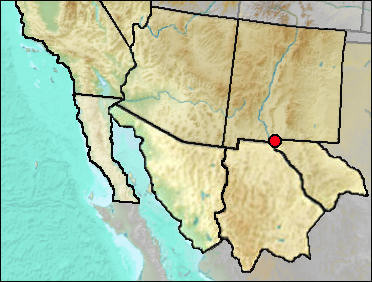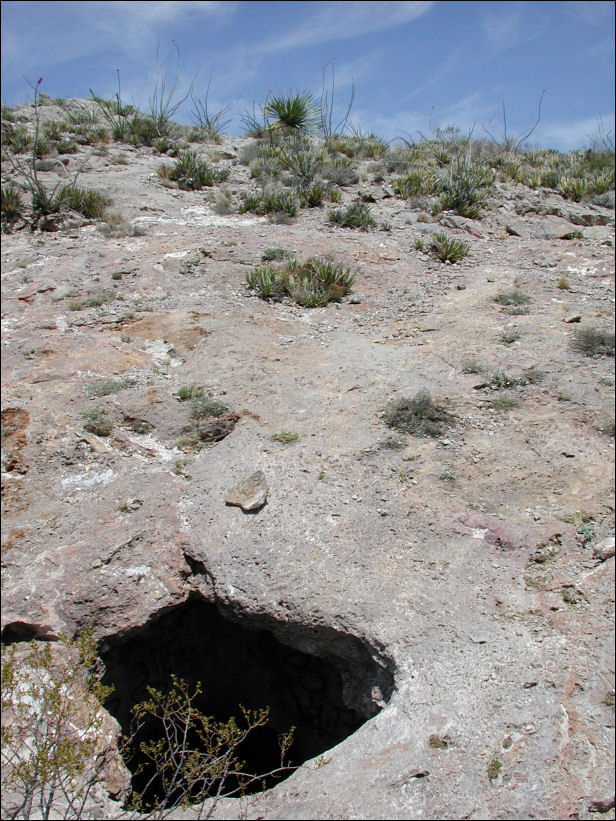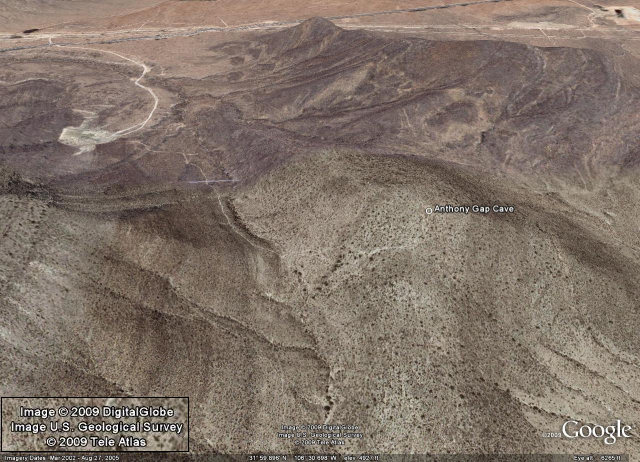 Age. Rancholabrean, possibly some
Holocene. No dates are available, but presence of Aztlanolagus agilis and
Neotoma ? goldmani suggests that the mid or early Wisconsin is
represented by at least those sites within the cave that have those taxa. Smartt
(1977:11) commented that site 29-D "seems to represent either a Recent assemblage
or an interpluvial fauna." Others were hypothesized by him to represent a late
Pleistocene pluvial period.
Age. Rancholabrean, possibly some
Holocene. No dates are available, but presence of Aztlanolagus agilis and
Neotoma ? goldmani suggests that the mid or early Wisconsin is
represented by at least those sites within the cave that have those taxa. Smartt
(1977:11) commented that site 29-D "seems to represent either a Recent assemblage
or an interpluvial fauna." Others were hypothesized by him to represent a late
Pleistocene pluvial period.
General Description. Franklin Mts., ca. 6 mi E Anthony, ca. 1540 m. The cave is about 10 km east of the present course of the Rio Grande and currently is located in the Franklin Mountain State Park. Although published as Anthony Cave, the original and more appropriate name is Anthony Gap Cave, Anthony Gap being the pass between the Franklin Mountains and the North Franklin Mountains. There has been some confusion as to whether the fossil cave and Anthony Gap Cave are one and the same; it now appears that they are.
 Discussion. This is a small limestone
cave, badly vandalized, with a vertical entrance about 1 m square on a south-facing
slope of a small limestone ridge (Smartt 1977). The entrance, at no more than 15 m from
the top of the ridge has an inconsequential drainage area. The entrance probably was
blocked by fill inside the entrance until tunneled through at some unknown time by
unknown people. Faunal remains were found scattered at various locations within the 90
m or so of cave passage and probably originated from fissures that intersected the
surface at various times.
Discussion. This is a small limestone
cave, badly vandalized, with a vertical entrance about 1 m square on a south-facing
slope of a small limestone ridge (Smartt 1977). The entrance, at no more than 15 m from
the top of the ridge has an inconsequential drainage area. The entrance probably was
blocked by fill inside the entrance until tunneled through at some unknown time by
unknown people. Faunal remains were found scattered at various locations within the 90
m or so of cave passage and probably originated from fissures that intersected the
surface at various times.
The current vegetation (Smartt and Harris 1979) is Chihuahuan desertscrub, with Creosotebush (Larrea tridentata), White-thorn (Acacia constricta), Ocotillo (Fouquieria splendens), and Mormon Tea (Ephedra trifurca). The nearby, more mesic canyon bottoms support sumacs (Rhus choriophylla, R. aromatica), Silktassel (Garrya wrightii), oaks (Quercus), and Mountain Mahogany (Cercocarpus montanus). Smartt and Harris (1979) reported the recovery of a spruce (Picea) needle from deposits below a thin layer of flowstone. Accompanying fauna included Meadow Vole (Microtus pennsylvanicus), Montane Vole (M. montanus), and Merriam's Shrew (Sorex merriami).
Fig. 1. Entrance to Anthony Gap Cave and view upslope, showing the rather limited watershed available for washing in of faunal remains. The skyline is the approximate crest of the ridge. Desert vegetation visible includes Creosotebush (foreground), Lechuguilla, Ocotillo, and Torrey Yucca.
Seven areas were sampled (Smartt 1977), including spoil presumably resulting from the original digging out of the entrance.
Smartt and Harris (1979) hypothesized that the recovered fossils indicated a late Pleistocene pluvial period characterized by a good cover of grasses and montane conifers. Metcalf (1971) studied gastropods from nearby Pleistocene slope deposits and concluded that they likely indicated a mesic flora including Gambel Oak, pine, and fir.
Presence or absence of Microtus montanus critical here. Invertebrate fauna includes the snail Gastrocopta procera (Smartt 1977). Smartt (1977) listed some taxa from the presumed pluvial sites, but did not indicate the specific sites from which they were recovered other than to note that all sites except D included Microtus. Taxa mentioned by him are noted in the UTEP collections.
Fig. 2. Google Earth image showing the position of Anthony Gap Cave, north to the top. Anthony Gap, with NM highway 404, runs east and west at the top of the photograph. The gravel road and trail leading to the cave runs from upper left to center. The faint lavender horizontal line crossing the trail marks the New Mexico/Texas state line.

Corridor just S large chamber
Equus—Horses
Site 1
Microtus montanus—Montane Vole
Microtus pennsylvanicus—Meadow Vole
Neotoma cinerea—Bushy-tailed Woodrat
Neotoma leucodon—White-toothed Woodrat
Aztlanolagus agilis—Aztlán Rabbit
Sylvilagus audubonii—Desert Cottontail
Sylvilagus nuttallii—Mountain Cottontail
Notiosorex dalquesti—Dalquest's Shrew (Carraway 2010)
Canis latrans—Coyote (cf.)
Bassariscus astutus—Ringtail
Site 1, Level 1
Tamias sp.—Chipmunk
Neotoma cinerea—Bushy-tailed Woodrat
Neotoma goldmani—Goldman's Woodrat (?)
Neotoma leucodon—White-toothed Woodrat
Aztlanolagus agilis—Aztlán Rabbit
Lepus—Jackrabbits
Site 2
Microtus mogollonensis—Mogollon Vole
Microtus montanus—Montane Vole
Site 2 + 3
Neotoma cinerea—Bushy-tailed Woodrat
Thomomys bottae—Botta's Pocket Gopher
Sorex neomexicanus—New Mexican Shrew (cf.)
Lynx rufus—Bobcat
Equus—Horses
Site 4 (=D)
Neotoma goldmani —Goldman's Woodrat (?)
Aztlanolagus agilis—Aztlán Rabbit
Site 4 Level 1
Sauria. Lizards
Peromyscus—White-footed Mice
Urocyon cinereoargenteus—Gray Fox
A/1
Microtus mogollonensis—Mogollon Vole
Microtus montanus—Montane Vole
B/1
Microtus mogollonensis—Mogollon Vole
Microtus montanus—Montane Vole
Neotoma cinerea—Bushy-tailed Woodrat
Neotoma leucodon—White-toothed Woodrat
Notiosorex dalquesti—Dalquest's Shrew (Carraway 2010)
C/1
Microtus montanus—Montane Vole
Neotoma leucodon—White-toothed Woodrat
Sorex merriami—Merriam's Shrew
D/1
Microtus—Voles
E/1
Microtus mogollonensis—Mogollon Vole
F/1
Microtus—Voles
G/1
Microtus —Voles
Literature. Carraway 2010; Harris 1984b, 1985a; Metcalf 1971; Smartt 1972, Smartt 1977; Smartt and Harris 1979.
Last Update: 18 Jul 2010